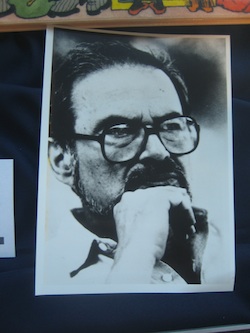By Neal Schindler , Special to JTNews
The wild rumpus began around 6:30 p.m. In front of buffets packed with lox, knishes, and apricot kuchen, the Kosher Red Hots, Spokane’s preeminent klezmer band, began whirling out songs in Yiddish and getting the sizable crowd to sing along. During the first tune, a little girl stood in front of the band, transfixed.
It was an image right out of Maurice Sendak: a curious child coming face to face with the wonder of the unknown. As it happens, this particular child was attending the opening reception for “In a Nutshell: The Worlds of Maurice Sendak.” The touring exhibit originated at Philadelphia’s Rosenbach Museum & Library, the world’s largest repository of work by the beloved children’s author and illustrator. By the end of its travels, “In a Nutshell” will have visited 35 libraries from Quebec to Wyoming. Eastern Washington University’s John F. Kennedy Library in Cheney, Wash. joined the itinerary thanks to the efforts of several local bibliophiles, as well as support from nearby Spokane’s Temple Beth Shalom, which is cosponsoring the exhibit.
Sendak was born in Brooklyn, to Jewish immigrants from Poland, in 1928. Much of his extended family died in the Holocaust. Inspired by the movie Fantasia to become an artist, he began his career as an illustrator of children’s books. In less than a decade, he became an author as well. He has illustrated several books on overtly Jewish themes, including Isaac Bashevis Singer’s Zlateh the Goat (1966) and Tony Kushner’s Brundibar (2003), an adaptation of a children’s opera originally performed at the Theresienstadt concentration camp. In 1982, Sendak won the National Book Award for Outside Over There, whose premise recalls the 1932 kidnapping of Charles Lindbergh, Jr.
Nadean Meyer, EWU’s learning resources librarian, was instrumental in bringing “In a Nutshell” to Cheney. When the university’s former associate dean of libraries, Julie Miller, learned about the opportunity to host the exhibit, she contacted Meyer. Soon they had formed a subcommittee and brought in former Temple Beth Shalom president Karrie Brown, who is also a storyteller specializing in Jewish folktales. After the women secured hosting privileges and a grant, EWU’s board of trustees contributed money for events related to Sendak’s oeuvre and Jewish culture.
“When the Sendak exhibit came up, I saw it as an opportunity to connect with Spokane’s Jewish community,” Miller said.
EWU hadn’t hosted many Jewish cultural events in the past, but both the university and the library were eager to develop diversity programming. Miller noted that many Spokanites have little knowledge of Jewish traditions, so “In a Nutshell” could serve as a kind of “Jewish Culture 101″ for the wider community.
To this end, children from Temple Beth Shalom’s Hebrew school created collages that illustrate key elements of Jewish faith and cultural identity. The collages are now part of the exhibit: A creative response to Sendak’s art from a new generation of potential fans.
“In a Nutshell” features a collection of informative panels from the Rosenbach. Each takes a deeper look at aspects of Sendak’s life and creative output. Newcomers to his worlds may be dazzled by the incredibly detailed drawings; longtime Sendak fans will likely discover things they didn’t know. One panel deals with the impact of the Lindbergh baby’s kidnapping on Sendak, who was 3 years old at the time, and that event’s influence on his stories. Several other panels examine Sendak’s experience as a child of immigrants.
The exhibit also provides plenty of Sendakiana: “We have several people who have loaned their Sendak books,” Meyer said. “First editions, dolls of the Wild Things and Rosie, exhibit catalogues, and [a] special signed Clinton inauguration drawing.”
The “Rosie” Meyer refers to is a Sendak character who became the subject of a musical, Really Rosie, with songs by Carole King. The Spokane Area Children’s Chorus, led by EWU music professor Kristina Ploeger, performed a shortened version of the show Nov. 9 in the library’s lobby.
